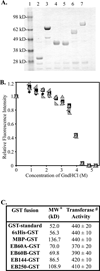Sweeping away protein aggregation with entropic bristles: intrinsically disordered protein fusions enhance soluble expression
- PMID: 22924672
- PMCID: PMC4141500
- DOI: 10.1021/bi300653m
Sweeping away protein aggregation with entropic bristles: intrinsically disordered protein fusions enhance soluble expression
Abstract
Intrinsically disordered, highly charged protein sequences act as entropic bristles (EBs), which, when translationally fused to partner proteins, serve as effective solubilizers by creating both a large favorable surface area for water interactions and large excluded volumes around the partner. By extending away from the partner and sweeping out large molecules, EBs can allow the target protein to fold free from interference. Using both naturally occurring and artificial polypeptides, we demonstrate the successful implementation of intrinsically disordered fusions as protein solubilizers. The artificial fusions discussed herein have a low level of sequence complexity and a high net charge but are diversified by means of distinctive amino acid compositions and lengths. Using 6xHis fusions as controls, soluble protein expression enhancements from 65% (EB60A) to 100% (EB250) were observed for a 20-protein portfolio. Additionally, these EBs were able to more effectively solubilize targets compared to frequently used fusions such as maltose-binding protein, glutathione S-transferase, thioredoxin, and N utilization substance A. Finally, although these EBs possess very distinct physiochemical properties, they did not perturb the structure, conformational stability, or function of the green fluorescent protein or the glutathione S-transferase protein. This work thus illustrates the successful de novo design of intrinsically disordered fusions and presents a promising technology and complementary resource for researchers attempting to solubilize recalcitrant proteins.
Figures





Similar articles
-
An Intrinsically Disordered Peptide Tag that Confers an Unusual Solubility to Aggregation-Prone Proteins.Appl Environ Microbiol. 2022 Apr 12;88(7):e0009722. doi: 10.1128/aem.00097-22. Epub 2022 Mar 14. Appl Environ Microbiol. 2022. PMID: 35285717 Free PMC article.
-
Synthetic intrinsically disordered protein fusion tags that enhance protein solubility.Nat Commun. 2024 May 2;15(1):3727. doi: 10.1038/s41467-024-47519-7. Nat Commun. 2024. PMID: 38697982 Free PMC article.
-
Thioredoxin fusions increase folding of single chain Fv antibodies in the cytoplasm of Escherichia coli: evidence that chaperone activity is the prime effect of thioredoxin.J Mol Biol. 2006 Mar 17;357(1):49-61. doi: 10.1016/j.jmb.2005.12.058. Epub 2006 Jan 6. J Mol Biol. 2006. PMID: 16427080
-
Enhancing the solubility of recombinant proteins in Escherichia coli by using hexahistidine-tagged maltose-binding protein as a fusion partner.Methods Mol Biol. 2011;705:259-74. doi: 10.1007/978-1-61737-967-3_16. Methods Mol Biol. 2011. PMID: 21125392 Review.
-
Mutual effects of disorder and order in fusion proteins between intrinsically disordered domains and fluorescent proteins.Mol Biosyst. 2012 Jan;8(1):105-13. doi: 10.1039/c1mb05244f. Epub 2011 Aug 18. Mol Biosyst. 2012. PMID: 21850362 Review.
Cited by
-
Intrinsically disordered sequences enable modulation of protein phase separation through distributed tyrosine motifs.J Biol Chem. 2017 Nov 17;292(46):19110-19120. doi: 10.1074/jbc.M117.800466. Epub 2017 Sep 18. J Biol Chem. 2017. PMID: 28924037 Free PMC article.
-
Protein aggregation profile of the human kinome.Front Physiol. 2012 Nov 20;3:438. doi: 10.3389/fphys.2012.00438. eCollection 2012. Front Physiol. 2012. PMID: 23181023 Free PMC article.
-
Structure and Multitasking of the c-di-GMP-Sensing Cellulose Secretion Regulator BcsE.mBio. 2020 Aug 11;11(4):e01303-20. doi: 10.1128/mBio.01303-20. mBio. 2020. PMID: 32788377 Free PMC article.
-
Quality Screening of Incorrectly Folded Soluble Aggregates from Functional Recombinant Proteins.Int J Mol Sci. 2019 Feb 19;20(4):907. doi: 10.3390/ijms20040907. Int J Mol Sci. 2019. PMID: 30791505 Free PMC article.
-
Protein structure-function continuum model: Emerging nexuses between specificity, evolution, and structure.Protein Sci. 2024 Apr;33(4):e4968. doi: 10.1002/pro.4968. Protein Sci. 2024. PMID: 38532700 Free PMC article. Review.
References
-
- Christendat D, Yee A, Dharamsi A, Kluger Y, Savchenko A, Cort JR, Booth V, Mackereth CD, Saridakis V, Ekiel I, Kozlov G, Maxwell KL, Wu N, McIntosh LP, Gehring K, Kennedy MA, Davidson AR, Pai EF, Gerstein M, Edwards AM, Arrowsmith CH. Structural proteomics of an archaeon. Nat Struct Biol. 2000;7:903–909. - PubMed
-
- Christendat D, Yee A, Dharamsi A, Kluger Y, Gerstein M, Arrowsmith CH, Edwards AM. Structural proteomics: prospects for high throughput sample preparation. Prog Biophys Mol Biol. 2000;73:339–345. - PubMed
Publication types
MeSH terms
Substances
Grants and funding
LinkOut - more resources
Full Text Sources

